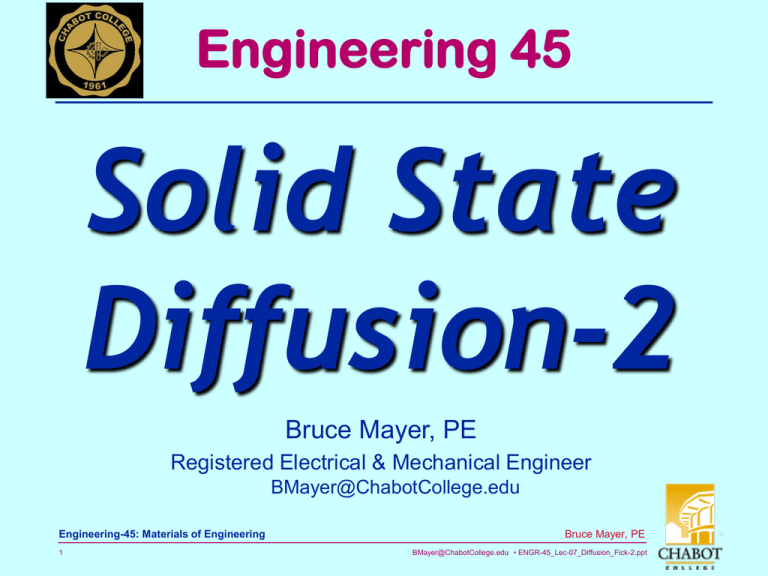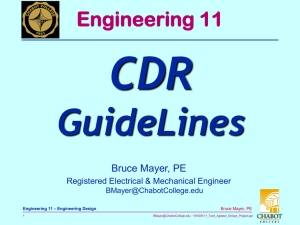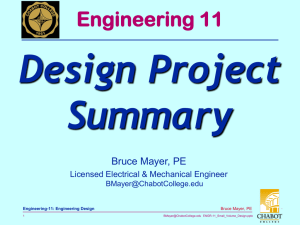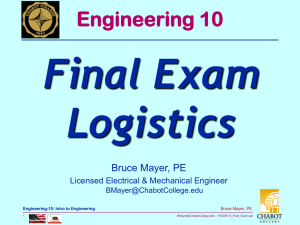Solid State Diffusion-2 Engineering 45 Bruce Mayer, PE
advertisement

Engineering 45 Solid State Diffusion-2 Bruce Mayer, PE Registered Electrical & Mechanical Engineer BMayer@ChabotCollege.edu Engineering-45: Materials of Engineering 1 Bruce Mayer, PE BMayer@ChabotCollege.edu • ENGR-45_Lec-07_Diffusion_Fick-2.ppt Learning Goals - Diffusion How Diffusion Proceeds How Diffusion Can be Used in Material Processing How to Predict The Rate Of Diffusion Be Predicted For Some Simple Cases • Fick’s first and SECOND Laws How Diffusion Depends On Structure And Temperature Engineering-45: Materials of Engineering 2 Bruce Mayer, PE BMayer@ChabotCollege.edu • ENGR-45_Lec-07_Diffusion_Fick-2.ppt Fick’s 1st Law dC J D dx • Where – J Flux in kg/m2•s or at/m2•s – dC/dx = Concentration GRADIENT in units of kg/m4 or at/m4 – D Proportionality Constant (Diffusion Coefficient) in m2/s Engineering-45: Materials of Engineering 3 Concen., C Recall Fick’s FIRST Law. Cu flux Ni flux x C Position, x In the SteadyState Case J = const • So dC/dx = const – For all x & t Thus for ANY two points j & k dC C Ck C j dx x xk x j Bruce Mayer, PE BMayer@ChabotCollege.edu • ENGR-45_Lec-07_Diffusion_Fick-2.ppt NONSteady-State Diffusion In The Steady Case In The NONSteady, or Transient, Case the Physical Conditions Require J , C, dC dx f x, t Engineering-45: Materials of Engineering 4 Increasing Time 0.8 Vapor Saturation Fraction, v J f t C f t Liquid Source Vapor Bubble Saturation Transient (Calculated) 1.0 n 0.6 v r , t 1 2 1 n1 0.4 sin n r ro n r r0 en 2 2 2 D v t / ro Pv(r,t) (t=0.01) Pv(r,t) (t=0.04 s) Pv(r,t) (t=0.10 s) Pv(r,t) (t=0.15 s) 0.2 Pv(r,t) (t=0.2 s) Pv(r,t) (t=0.3 s) • Bubble Diameter = 4 mm • Dv = 5 mm2/s Pv(r,t) (t=0.35 s) 0.0 0.0 0.2 0.4 0.6 0.8 1.0 1.2 1.4 Radial Position Inside Bubble, r (mm) 1.6 • In The Above Concen-vs-Position Plot Note how, at x 1.5 mm, Both C and dC/dx CHANGE with Time Bruce Mayer, PE BMayer@ChabotCollege.edu • ENGR-45_Lec-07_Diffusion_Fick-2.ppt 1.8 2.0 file = BubPv(t)2.xls NONSteady State Diffusion Math x Consider the Situation at Right Box Dimensions • Width = x • Height = 1 m • Depth = 1 m – Into the slide Box Volume, V = x•1•1 = x Now if x is small Engineering-45: Materials of Engineering 5 J(left) J(right) Concentration, C, in the Box • Can Approximate C(x) as Cavg Cleft Cright 2 C x The Amount of Matl in the box, M kg 3 M C V 3 m m Bruce Mayer, PE BMayer@ChabotCollege.edu • ENGR-45_Lec-07_Diffusion_Fick-2.ppt NONSteady State Diffusion cont dx or M C 11 x Cx Material ENTERING the Box in time t M in J left Area t J left 11 J left t J(left) J(right) Concentration C, in the Box For NONsteady Conditions Material LEAVING the J left J right Box in time t So Matl M out J right Area t ACCUMULATES in the Box J right 11 J rightt Engineering-45: Materials of Engineering 6 Bruce Mayer, PE BMayer@ChabotCollege.edu • ENGR-45_Lec-07_Diffusion_Fick-2.ppt NONSteady State Diffusion cont.2 x So the NET Matl Accumulation M J left J right t J(left) J(right) Concentration C, in the Box Adding (or With V = 1•1•x Subtracting) Matl 11 x C J left J right t or From the Box CHANGES C(x) C C C x D D M M Cnew Cold C t x x x x x V V M Partials Req’d as C M V C C = C(x,t) V Engineering-45: Materials of Engineering 7 Bruce Mayer, PE BMayer@ChabotCollege.edu • ENGR-45_Lec-07_Diffusion_Fick-2.ppt NONSteady State Diffusion cont.3 x In Summary for CONSTANT D C C C x D t x x x x J(left) J(right) x Concentration C, in the Box Now, And this is CRITICAL, by TAYLOR’S SERIES C / x C xxx C xx x x x so C x x C C x D x t x x x Engineering-45: Materials of Engineering 8 C x x x Bruce Mayer, PE BMayer@ChabotCollege.edu • ENGR-45_Lec-07_Diffusion_Fick-2.ppt NONSteady State Diffusion cont.4 x After Canceling C x x C D t x C D x 2 J(left) 2 x J(right) Concentration C, in the Box x Now for very short t C C 2C 2C lim D D 2 2 t 0 t t x x x Finally Fick’s SECOND LAW for Constant Diffusion Coefficient Conditions C C D 2 t x 2 Engineering-45: Materials of Engineering 9 Bruce Mayer, PE BMayer@ChabotCollege.edu • ENGR-45_Lec-07_Diffusion_Fick-2.ppt Comments of Fick’s 2nd Law x The Formal Statement C C D 2 t x 2 This Assumes That D is Constant, i.e.; D DCx, t In many Cases Changes in C also Change D Engineering-45: Materials of Engineering 10 J(left) J(right) Concentration, C, in the Box This Leads to the GENERAL, and much more Complicated, Version of the 2nd Law C C D t x x Bruce Mayer, PE BMayer@ChabotCollege.edu • ENGR-45_Lec-07_Diffusion_Fick-2.ppt Example – NonSS Diffusion Example: Cu Diffusing into a Long Al Bar Surface conc., Csof Cu atoms bar pre-existing conc., Co of copper atoms The Copper Concentration vs x & t The General Soln is Gauss’s Error C(x,t) Function, “erf” Cs Co to t1 C x , t Co x 1 erf C S Co 2 Dt t3 t2 position, x Engineering-45: Materials of Engineering 11 Bruce Mayer, PE BMayer@ChabotCollege.edu • ENGR-45_Lec-07_Diffusion_Fick-2.ppt Comments on the erf Gauss's Defining Eqn erf z 2 z e 0 y2 dy z is just a NUMBER • Thus the erf is a (hard to evaluate) DEFINITE Integral Treat the erf as any other special Fcn Engineering-45: Materials of Engineering 12 Some Special Fcns with Which you are Familiar: sin, cos, ln, tanh • These Fcns used to be listed in printed Tables, but are now built into Calculators and MATLAB See Text Tab 5.1 for Table of erf(z) Bruce Mayer, PE BMayer@ChabotCollege.edu • ENGR-45_Lec-07_Diffusion_Fick-2.ppt Comments on the erf cont. 1-erf(z) appears So Often in Physics That it is Given its Own Name, The COMPLEMENTARY Error Function: C x , t Co x erfc C S Co 4 Dt Notice the Denom in this Eqn 4Dt Ld This Qty has SI 2 z y2 erfcz 1 e dy Units of meters, and 0 is called the “Diffusion Length” Recall The erfc • The Natural Scaling Diffusion solution Factor in the efrc Engineering-45: Materials of Engineering 13 Bruce Mayer, PE BMayer@ChabotCollege.edu • ENGR-45_Lec-07_Diffusion_Fick-2.ppt SemiInfite Slab Diffusion vs Time 1.0 ErfC t1; Ld = 0.2236 0.9 ErfC t2; Ld = 0.3873 0.8 ErfC t3; Ld = 0.6708 Relative Concentation TIME ErfC t4; Ld = 1.1619 0.7 ErfC t5; Ld = 2.0125 0.6 0.5 PARAMETERS • D = 0.05 (arb Units) 0.4 0.3 0.2 0.1 0.0 0.0 0.2 0.4 0.6 file = erfc_0401.xls Engineering-45: Materials of Engineering 14 0.8 1.0 1.2 1.4 1.6 x (arbitrary units) Bruce Mayer, PE BMayer@ChabotCollege.edu • ENGR-45_Lec-07_Diffusion_Fick-2.ppt 1.8 2.0 Example D = f(T) Given Cu Diffusing into an Al Bar At given point in the bar, x0, The Copper Concentration reaches the Desired value after 10hrs at 600 °C Get a New Firing Furnace that is Only rated to 1000 °F = 538 °C • To Be Safe, Set the New Fnce to 500 °C Need to Find the NEW Processing • The Processing TIME for 500 °C to Recipe yield the desired C x0 10hrs @ 600C C(x0) Engineering-45: Materials of Engineering 15 Bruce Mayer, PE BMayer@ChabotCollege.edu • ENGR-45_Lec-07_Diffusion_Fick-2.ppt Example D = f(T) cont Recall the erf Diffusion Eqn x0 x0 1 erf 1 erf 4 D 10hrs 4D t 600 500 C x , t Co x 1 erf C S Co 4 Dt Since CS and Co have NOT changed, Need C x0 ,10hrs 600C Co C x0 , t 500C Co CS Co CS Co Since by the erf Engineering-45: Materials of Engineering 16 For this Eqn to be True, need Equal Denoms in the erf D600 10hrs D500 t or D600 10hrs t D500 Bruce Mayer, PE BMayer@ChabotCollege.edu • ENGR-45_Lec-07_Diffusion_Fick-2.ppt Example D = f(T) cont.2 Now Need to Find D(T) As With Xtal PtDefects, D Follows an Arrhenius Rln Qd D D0 exp RT • Where – D0 Temperature INdependent Exponential PreFactor in m2/s Engineering-45: Materials of Engineering 17 – Qd Arrhenius Activation Energy in J/mol or eV/at – R Gas Constant = 8.31 J/mol-K = 8.62x10-5 eV/at-K – T Temperature in K Find D0 and Qd from Tab 5.2 in Text • For Cu in Al – D0 = 6.5x10-5 m2/s – Qd = 136 kJ/mol Bruce Mayer, PE BMayer@ChabotCollege.edu • ENGR-45_Lec-07_Diffusion_Fick-2.ppt Example D = f(T) cont.3 Thus D(T) for Cu in Al Thus for the new 500 °C Recipe In this Case 46.92 10hrs t 113.0hrs 4.152 136000 J / mol D 6.5 10 5 exp 8.31J / mol K T • D600 = 4.692x10-13 m2/s • D500 = 4.152x10-14 m2/s Now Recall the Problem Solution D600 10hrs t D500 Engineering-45: Materials of Engineering 18 This is 10x LONGER than Before; Should have bought a 600C fnce Bruce Mayer, PE BMayer@ChabotCollege.edu • ENGR-45_Lec-07_Diffusion_Fick-2.ppt Find D Arrhenius Parameters Recall The D(T) Rln y b mx Qd D D0 exp Applied to the D(T) RT Relation Take the Natural Log of this Eqn y ln D Qd ln D ln D0 R 1 T This takes the form of the slope-intercept Line Eqn: Engineering-45: Materials of Engineering 19 m -Qd R x 1 T b ln D0 Bruce Mayer, PE BMayer@ChabotCollege.edu • ENGR-45_Lec-07_Diffusion_Fick-2.ppt Find D(T) Parameters cont And, Since TWO Points Define a Line If We Know D(T1) and D(T2) We can calc • D0 • Qd Quick Example • D(T) For Cu in Au at Upper Right Engineering-45: Materials of Engineering 20 y x Slope, m = y/x • x = (1.1-0.8)x1000/K • = 0.0003 K-1 • y = ln(3.55x10-16) − ln(4x10-13) = −7.023 Bruce Mayer, PE BMayer@ChabotCollege.edu • ENGR-45_Lec-07_Diffusion_Fick-2.ppt Find D(T) Parameters cont.2 By The Linear Form m Qd R or Qd R m Ry x Qd 8.31 7.023 0.0003 Qd 194500 J/mol Now, the intercept, b y mx b or b y1mx1 Pick (D,1/T) pt as • (4x10-13,0.8) Engineering-45: Materials of Engineering 21 in the (x,y) format • x1 = 0.0008 • y1 = ln(4x10-13) = −28.55 So b 7.023 b 28.55 0.0008 0.0003 b 9.819 Finally D0 D0 eb e 9.819 D0 5.44 105 m 2 s Bruce Mayer, PE BMayer@ChabotCollege.edu • ENGR-45_Lec-07_Diffusion_Fick-2.ppt Diff vs. Structure & Properties Faster Diffusion for Slower Diffusion for • Open crystal structures • Lower melting Temp materials • Materials with secondary bonding • Smaller diffusing atoms • Cations • Lower density materials • Close-packed structures • Higher melting Temp materials • Materials with covalent bonding • Larger diffusing atoms • Anions • Higher density materials Engineering-45: Materials of Engineering 22 Bruce Mayer, PE BMayer@ChabotCollege.edu • ENGR-45_Lec-07_Diffusion_Fick-2.ppt Diffusion Summarized Phenomenon: Mass Transport In Solids Mechanisms • Vacancy InterChange by KickOut • Interstitial “squeezing” Governing Equations • Fick's First Law • Fick's Second Law Diffusion coefficient, D • Affect of Temperature • Qd & D0 – How to Determine them from D(T) Data Engineering-45: Materials of Engineering 23 Bruce Mayer, PE BMayer@ChabotCollege.edu • ENGR-45_Lec-07_Diffusion_Fick-2.ppt WhiteBoard Work Problem 5.28 • Ni Transient Diffusion into Cu Prob 5.28: Ni Diffusion into Cu 5% 500hrs @ 1000 ° 500hrs @ T2 CNi (Wt% Ni in Cu) 4% Same Concentration 3% 2% 1% 0% 0.0 0.5 file = erfc_0401.xls Engineering-45: Materials of Engineering 24 1.0 1.5 2.0 x into Cu (mm) 2.5 3.0 Bruce Mayer, PE BMayer@ChabotCollege.edu • ENGR-45_Lec-07_Diffusion_Fick-2.ppt





